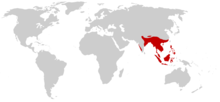King cobra
The king cobra (Ophiophagus hannah) is in the Elapidae family of snakes. It is the longest venomous snake in the world. An adult king cobra can grow up to 18 feet (5.5 m), though most are less than 12 ft (3.7 m).[2][3] It is endemic to Asia.
| King cobra | |
|---|---|

| |
| Scientific classification | |
| Domain: | Eukaryota |
| Kingdom: | Animalia |
| Phylum: | Chordata |
| Class: | Reptilia |
| Order: | Squamata |
| Suborder: | Serpentes |
| Family: | Elapidae |
| Subfamily: | Elapinae |
| Genus: | Ophiophagus Günther, 1864 |
| Species: | O. hannah
|
| Binomial name | |
| Ophiophagus hannah Cantor, 1836
| |

| |
Distribution of the king cobra
| |
| Synonyms | |
|
Genus-level:
| |


King cobras are the longest of all venomous snakes. As they face a variety of threats stemming from human activities, these snakes are vulnerable to extinction.
The king cobra lives throughout India and in some parts of the south and the east of Asia. It is known around the world for its dangerous venom. It mostly avoids humans.[4] The King cobra lives up to 20 years.[5]
The king cobra lives in thick forests,[3][6] and likes areas dotted with lakes and streams.
It eats mostly other snakes but sometimes lizards and rodents.[7][8] After a large meal it may live months before eating again.[3]
The Indian grey mongoose is one of the few predators of the king cobra but may not attack them much.[9]
Venom
changeThe venom from a bite can be deadly. The snake can kill a man with a single bite.[7] The mortality rate can be as high as 75% without antivenom.[7][10][11]
There are two kinds of antivenom that can be used to help when someone is bitten. Bites do not happen often, snake handlers are most likely to be bitten.[4]
Parenting
changeUnlike many snakes, the female king cobra is a very good parent. It makes a mound as a nest for its eggs and protects them for 60-90 days until they hatch. It lays 20-40 eggs. [12] The mother stays until the eggs begin to hatch and then leaves to find food for herself. Baby king cobras are 18–22 inches (460–560 mm) and have venom as strong as adults.[4]
Growling hiss
changeThe hiss of the king cobra is a much lower pitch than many other snakes and many people thus liken its call to a "growl" rather than a hiss. While the hisses of most snakes are of a broad-frequency span ranging from roughly 3,000 to 13,000 Hz with a dominant frequency near 7,500 Hz, king cobra growls consist solely of frequencies below 2,500 Hz, with a dominant frequency near 600 Hz, a much lower-sounding frequency closer to that of a human voice. Comparative anatomical morphometric analysis has led to a discovery of tracheal diverticula that function as low-frequency resonating chambers in king cobra and its prey, the rat snake, both of which can make similar growls.
References
change- ↑ Stuart, B.; Wogan, G.; Grismer, L.; Auliya, M.; Inger, R. F.; Lilley, R.; Chan-Ard, T.; Thy, N.; Nguyen, T. Q.; Srinivasulu, C.; Jelić, D. (2012). "Ophiophagus hannah". The IUCN Red List of Threatened Species. 2012. IUCN: e.T177540A1491874. doi:10.2305/IUCN.UK.2012-1.RLTS.T177540A1491874.en.
- ↑ "Cobra". Encyclopædia Britannica. Retrieved 2010-10-10.
- ↑ 3.0 3.1 3.2 Mehrtens, John (1987). Living snakes of the world. New York: Sterling. ISBN 0-8069-6461-8.
- ↑ 4.0 4.1 4.2 O'Shea, Mark (2011). Venomous snakes of the world. Princeton University Press. ISBN 978-0-691-15023-9.
- ↑ "National geographic- KING COBRA". 10 September 2010.
They are fiercely aggressive when cornered; average life span in the wild: 20 years
- ↑ Miller, Harry (1970). "The cobra, India's 'good snake'". National Geographic. 20: 393–409.
- ↑ 7.0 7.1 7.2 Capula, Massimo; Behler (1989). Simon & Schuster's guide to reptiles and amphibians of the world. New York: Simon & Schuster. ISBN 0-6716-9098-1.
- ↑ Coborn, John (1991). The atlas of snakes of the world. TFH Publications. pp. 30, 452. ISBN 978-0-86622-749-0.
- ↑ Mondadori, Arnoldo 1988 (ed.). Great book of the animal kingdom. New York: Arch Cape Press. p. 301.
{{cite book}}: CS1 maint: numeric names: editors list (link) - ↑ "Ophitoxaemia (venomous snake bite)". Retrieved 2007-09-05.
- ↑ Sean Thomas. "Most dangerous snakes in the world". Retrieved 2007-09-05.
- ↑ Piper, Ross (2007). Extraordinary animals: an encyclopedia of curious and unusual animals. Westport, Connecticut: Greenwood Press. ISBN 978-0-313-33922-6.
Other websites
change- Real Audio format of a king cobra hissing Archived 2009-03-26 at the Wayback Machine
